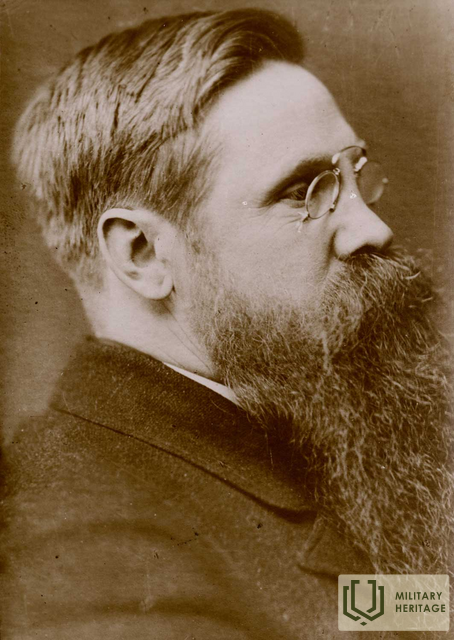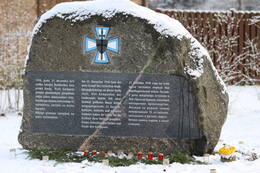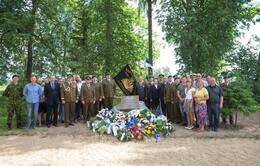Government of Andrievs Niedra
I WW1, I Wars of Independence
The government of Niedra was the Provisional Provisional Government of Latvia, which existed from May 10 to June 26, 1919, at the same time as the expelled Provisional Government of Kārlis Ulmanis and the government of Pēteris Stučkas LSPR.
After the overthrow of Ulmanis' Provisional Government in the coup of April 16, Andrievs Niedra arrived in Liepaja on April 27 as a mediator in talks with the Borkovskis government formed by the coup. At his request, on April 29, German cabinet ministers arrested by the Germans were released. The main topic of talks between the coups and the overthrown Provisional Government was the formation of a new compromise government, which would also include the Baltic Germans, as the most economically and militarily important part of the Latvian population. Niedra offered that the Germans publicly condemn the coup of April 16, but the People's Council instructed a new candidate to form a government consisting of 4 ministers of the Ulmanis government, 4 supporters of Niedra, 3 Germans and 1 Jew. Ulmanis rejected the offer.
Finally, on May 10, a new Cabinet of Ministers was established under the leadership of Andrieva Niedra. Most civil servants continued to perform their direct duties, regardless of the composition of the Cabinet at some point. The new government envisaged 3 main tasks for its existence: preservation of the state, restoration of the rule of law and the economy, expulsion of the Bolsheviks, elections to the Constitutional Assembly and the formation of a general government.
The reed government was in power until the end of June 1919, when after the defeat at the Battle of Cēsis, at a meeting of the Cabinet of Ministers on June 24, it was decided to address the Entente representatives and hand over their powers to them. Parts of the defeated Latvian National Guard and German mercenary troops (Iron Division) evacuated from Riga to Zemgale in accordance with the agreement reached in Strazdmuiža under the supervision of the Entente states. After the armistice of Strazdumuiža, the troops loyal to the Niedra cabinet, by delegating power to the government, either acknowledged the legitimacy of the renewal of the Cabinet of Ministers led by K. Ulmanis, or joined the so-called Western Russian Volunteer Army.
After the defeat of the Bermontians, A. Niedra emigrated and returned to Latvia in 1924, where he was accused of treason. A. Niedra's case as an accused in 1924 was considered in two lawsuits - separately for the coup of April 16, 1919 in Liepaja and separately for participation in Bermont's plans. He was sentenced to prison, which was later replaced by deportation. Niedra moved to East Prussia, where he served as a pastor. In 1942 he returned to Riga, where he also died.
More information sources
Wikipedia. Reed government. Available at: https://en.wikipedia.org/wiki/Niedras_vald%C4%ABba [accessed 06.05.2021].
Wikipedia. Andrievs Niedra. Available at: https://en.wikipedia.org/wiki/Andrievs_Niedra [accessed 06.05.2021].
Related timeline
Related objects
Monument to the first battle for Latvia's independence
Atroadas, Inčukalns, Atmodas Street 2.
On July 3, 2016, a monument to the first battle for Latvia's independence, dedicated to the Latvian National Guard (Die Lettländische Landeswehr), was unveiled. sides. Eižens Upmanis, the chairman of the Brothers' Cemetery Committee, concluded at the time that this could be the historically first monument to the combined Latvian and Baltic forces in the battle memorials outside the cemetery. At that time, Lieutenant Colonel Oskars Kalpaks was appointed commander of the Latvian units of the Latvian National Guard or Landesver, from whose units the later Latvian army grew and formed during the Freedom Fights.
In 1918, the entire territory of present-day Latvia had fallen into the hands of the German Empire and its troops. However, at the end of the summer and autumn of 1918, the situation began to end badly for Germany, and it was clear that it was only a matter of time before Germany would be forced to concede defeat in World War I. The Russian Empire, which included Latvia before World War I, had ceased to exist earlier, with the revolutions of February and October 1917. On November 18, 1918, the Republic of Latvia was proclaimed. After the ceasefire with the Entente on November 11, 1918, the German army, which was on the territory of Latvia, was no longer motivated for further warfare, and most of its soldiers simply wanted to return home.
Under such circumstances, it was clear that Latvia's defense depended primarily on the national guard formed by the people of Latvia. Initially, due to their education and relatively greater ability to self-organize, the greatest initiative in creating such a national guard was shown by the Baltic Germans living in Latvia. Russian soldiers also joined the National Guard. In order to ensure the supply of the National Guard with uniforms, weapons and other necessary resources, on December 7, 1918, the Provisional Government of Latvia entered into an agreement with the German representative August Vinnig, providing for the provision of the National Guard from the German army reserves in Latvia. This agreement stated, among other things, that the National Guard, officially known as the Latvian National Guard or in German, the die Lettländische Landeswehr, would be the armed forces of the Republic of Latvia.
Two soldiers of the Latvian Red Rifle Regiment (ie approximately 2,000 to 3,000 soldiers) who had previously experienced in World War I and the Russian Civil War faced the Latvian National Guard. Despite the experience and numerical superiority of the Red Army, the Latvian National Guard held Inčukalns for two days in fierce fighting, until finally, in the evening of January 1, 1919, to avoid siege, was forced to retire, losing 43 dead and several wounded, most of whom was taken captive by the Bolsheviks, where they were killed or died of starvation or disease.
Author: Artis Buks. Material: Boulder. The monument is made of large monolithic stone, which was found in Rolls near Jelgava.
Memorial at Skangaļi Manor
The memorial to the victory of the combined Latvian and Estonian troops in the battle for the Skangaļi Manor is located about 20 kilometres from Cēsis. Devoted to the participants of the Battles of Cēsis and the fighters of the Estonian Kalevlaste Maleva Battalion, the memorial stone was unveiled on 22 June 2019. The victory of the combined Latvian and Estonian troops in the battle for the Skangaļi Manor, which took place here, was a turning point in the Battles of Cēsis, as a result of which the troops of Niedra’s government initiated a general retreat. The government of Andrievs Niedra was a provisional pro-German government of Latvia, which existed from 10 May to 26 June 1919. The attack on the Landeswehr unit began in the early morning of 22 June 1919 when the 3rd Kalev company used an armoured train to break into the Skangaļi Manor where they seized 2 cannons, however, the enemy still went on a counterattack. The troops repeated the attack slightly later, in the middle of the day, and the Landeswehr unit was forced out of the Skangaļi Manor following fierce close combat. The trophies from the battle include machine guns, large quantities of ammunition and other combat equipment. Two hours later, the Estonians captured an important road junction at the Starti pub. 58 Kalev soldiers were injured or lost their lives in the battle to capture the Skangaļi Manor. Estonia provided significant support in establishing the memorial site.
Related stories
From Adolf Ers' book "Vidzeme in the Freedom Fights" about the life of refugees in Valka
From the time of the refugees, Valka agreed to play a more important role than other cities in Vidzeme, because the politically active newspaper Līdums was located here, where Latvia's spiritual and political weapons were minted, and also because there was a crossroads where roads from three On the Latvian side: from Riga, Alūksne, Mozekile, and also from Estonia and Russia, she had links with refugees everywhere - in Tartu, Pliskava, Moscow and St. Petersburg. There was a large refugee center here.








